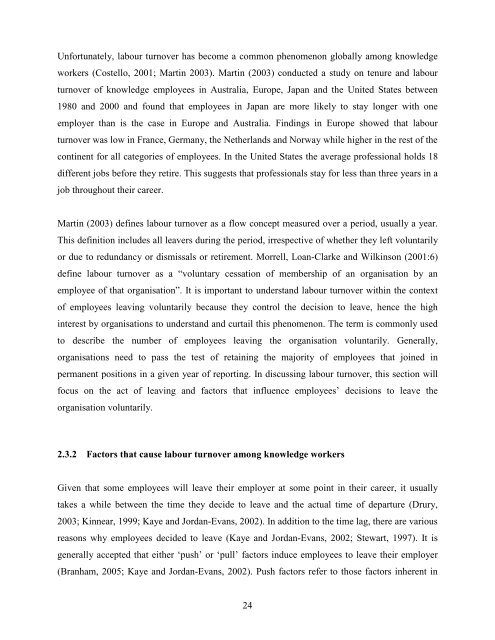Thami Nompula MBA Dissertation March 2007 - Rhodes eResearch ...
Thami Nompula MBA Dissertation March 2007 - Rhodes eResearch ...
Thami Nompula MBA Dissertation March 2007 - Rhodes eResearch ...
You also want an ePaper? Increase the reach of your titles
YUMPU automatically turns print PDFs into web optimized ePapers that Google loves.
Unfortunately, labour turnover has become a common phenomenon globally among knowledge<br />
workers (Costello, 2001; Martin 2003). Martin (2003) conducted a study on tenure and labour<br />
turnover of knowledge employees in Australia, Europe, Japan and the United States between<br />
1980 and 2000 and found that employees in Japan are more likely to stay longer with one<br />
employer than is the case in Europe and Australia. Findings in Europe showed that labour<br />
turnover was low in France, Germany, the Netherlands and Norway while higher in the rest of the<br />
continent for all categories of employees. In the United States the average professional holds 18<br />
different jobs before they retire. This suggests that professionals stay for less than three years in a<br />
job throughout their career.<br />
Martin (2003) defines labour turnover as a flow concept measured over a period, usually a year.<br />
This definition includes all leavers during the period, irrespective of whether they left voluntarily<br />
or due to redundancy or dismissals or retirement. Morrell, Loan-Clarke and Wilkinson (2001:6)<br />
define labour turnover as a “voluntary cessation of membership of an organisation by an<br />
employee of that organisation”. It is important to understand labour turnover within the context<br />
of employees leaving voluntarily because they control the decision to leave, hence the high<br />
interest by organisations to understand and curtail this phenomenon. The term is commonly used<br />
to describe the number of employees leaving the organisation voluntarily. Generally,<br />
organisations need to pass the test of retaining the majority of employees that joined in<br />
permanent positions in a given year of reporting. In discussing labour turnover, this section will<br />
focus on the act of leaving and factors that influence employees’ decisions to leave the<br />
organisation voluntarily.<br />
2.3.2 Factors that cause labour turnover among knowledge workers<br />
Given that some employees will leave their employer at some point in their career, it usually<br />
takes a while between the time they decide to leave and the actual time of departure (Drury,<br />
2003; Kinnear, 1999; Kaye and Jordan-Evans, 2002). In addition to the time lag, there are various<br />
reasons why employees decided to leave (Kaye and Jordan-Evans, 2002; Stewart, 1997). It is<br />
generally accepted that either ‘push’ or ‘pull’ factors induce employees to leave their employer<br />
(Branham, 2005; Kaye and Jordan-Evans, 2002). Push factors refer to those factors inherent in<br />
24

















